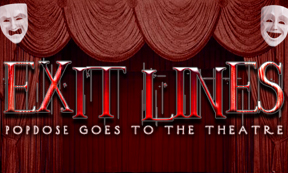 Halloween is just around the corner, and New York stages have been setting the stage for frights. The Broadway adaptation of 1984 was so upsetting, audience members were fainting or fleeing during its setpiece, where Winston Smith is gorily tortured in a coldly rendered torture room as the lighting turns eye-searingly white. I was marked “safe” after this event, if barely. (This was co-star Reed Birney’s second outing in a “haunted house” play; the first, the outstanding prize winner The Humans, is going on tour, and is very highly recommended.) The simultaneously revived In the Blood and Fucking A (a title that terrified The New York Times), two of Pulitzer winner Suzan-Lori Parks’ earlier plays, were awash in the residue of bloodletting and fucking, and wrought unsettling changes on their source, Hawthorne’s Scarlet Letter.
Halloween is just around the corner, and New York stages have been setting the stage for frights. The Broadway adaptation of 1984 was so upsetting, audience members were fainting or fleeing during its setpiece, where Winston Smith is gorily tortured in a coldly rendered torture room as the lighting turns eye-searingly white. I was marked “safe” after this event, if barely. (This was co-star Reed Birney’s second outing in a “haunted house” play; the first, the outstanding prize winner The Humans, is going on tour, and is very highly recommended.) The simultaneously revived In the Blood and Fucking A (a title that terrified The New York Times), two of Pulitzer winner Suzan-Lori Parks’ earlier plays, were awash in the residue of bloodletting and fucking, and wrought unsettling changes on their source, Hawthorne’s Scarlet Letter.
Amy Herzog’s Mary Jane is more chipper, its darkness, if I can call it that, hidden in a back room or concealed under a hospital bed sheet. Its protagonist, a single mother trying to make ends meet, is devoted to her two-year-old son, Alex. But Alex can hardly reciprocate her love. Born at just 25 weeks, Alex is plagued by ailments, including cerebral palsy, that require round-the-clock care. We never see Alex, just hear the whir of the machines that keep him breathing. We learn much about him, however, from Mary Jane, who gives voice to all caregivers, which we all inevitably become.
There’s an autobiographical component to Mary Jane, but Mary Jane’s struggles with work, bureaucracy, and her own conflicted heart are universal. One nugget of my father’s advice to me was “do the right things and the right things happen” and Mary Jane is always doing the right thing by Alex, patiently, kindly, and with a sense of humor. But, as we all learn, the right things don’t always result. By the second half of the play, Alex has taken a turn for the worst, and the storyline shifts from Mary Jane’s apartment in Jackson Heights, Queens, to a hospital room, a stark and stunning transformation arranged by scenic designer Laura Jellinek.
Mary Jane could conceivably be a one-woman show, a monologue of keeping despair at bay in a near-unmanageable situation. Gratifyingly, it isn’t, and indeed all five of the performers and most of the production team, including director Anne Kauffman, are women. It makes a difference. The 100-minute play finds time for all these female voices, who offer counterpoint to Mary Jane’s unflagging cheer. Ruthie (the veteran Brenda Wehle), the building superintendent, worries about Mary Jane’s health. Home care nurse Sherry (Liza Colon-Zayas) provides backup in negotiating the system. Brianne (Susan Pourfar), a new mom adrift in circumstances similar to Mary Jane’s, may be Mary Jane in an earlier phase, before acceptance became the order of her day. Appearing late in the play, Kat (Danaya Esperanza), as a hospital aide, offers a temporary lifeline, as a floodgate of emotion opens. I was devastated–how beautifully this whole play works, with such concerted effort from all involved.
One woman, however, is the beating heart of Mary Jane, and that is Carrie Coon. From the first time I saw her, as Honey in the 2013 Broadway revival of Who’s Afraid of Virginia Woolf?, I knew she was something special–so did Hollywood, which after that Tony-nominated turn cast her in Gone Girl, and gave her breakout roles on TV’s Fargo and The Leftovers. (So did co-star Tracy Letts, who married her.) Brimming with can-do spirit and optimism, breezing past every disaster (Mary Jane forgives Alex’s father for leaving), Coon doesn’t make Mary Jane a paragon of virtue, or settle for a mere everyday heroine. She makes her sweetly, gently, agonizingly human.





Comments